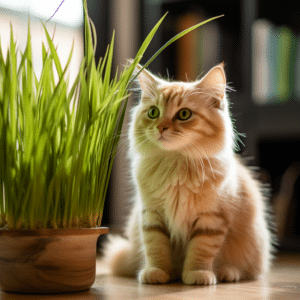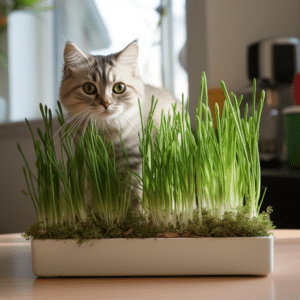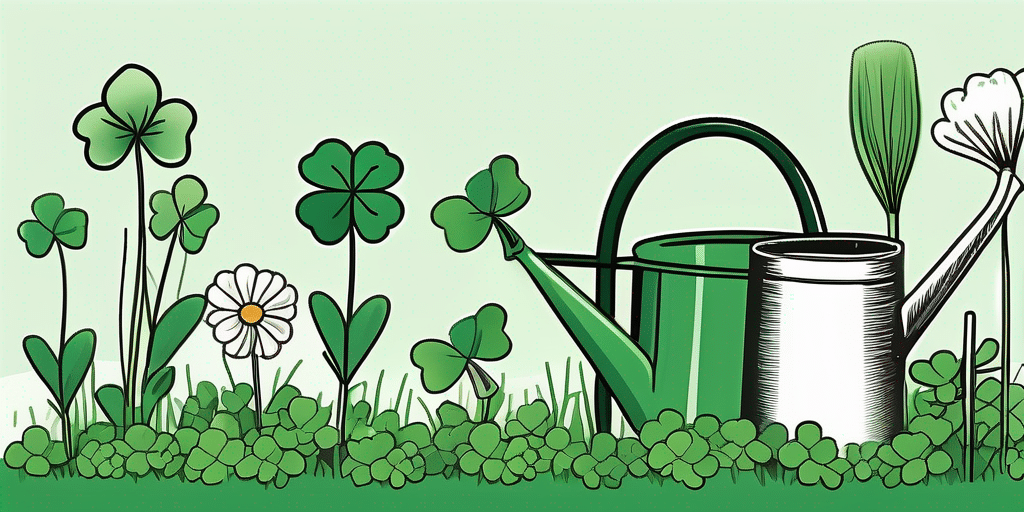Cat grass is a type of grass that is specifically grown for cats to nibble on. It provides a natural and safe way for your feline friend to satisfy their instinctual urge to chew on grass. In addition to being a tasty treat for cats, cat grass also offers several benefits for their overall well-being. If you’re interested in growing cat grass at home, this comprehensive guide will walk you through everything you need to know.
Understanding Cat Grass

What is Cat Grass?
Cat grass refers to a collection of grasses that are safe for cats to consume. It typically includes common grasses like wheatgrass, oatgrass, and barley grass. These grasses are rich in nutrients and are easy for cats to digest.
Benefits of Cat Grass for Your Feline Friend
Cat grass provides various benefits for your cat’s health. Firstly, chewing on grass helps to promote healthy digestion by aiding in the elimination of hairballs. When cats groom themselves, they ingest fur that can accumulate in their stomach. By nibbling on cat grass, your feline companion can naturally expel these hairballs.
Additionally, cat grass can serve as a natural source of essential vitamins and minerals. It contains nutrients like vitamin A, vitamin C, and dietary fiber, which can support your cat’s overall well-being. Vitamin A is crucial for maintaining good vision and a healthy immune system, while vitamin C helps in collagen production and acts as an antioxidant. Dietary fiber, on the other hand, aids in regulating digestion and preventing constipation.
Moreover, cat grass can provide mental and emotional stimulation for your cat. Chewing on grass can be a soothing and enjoyable activity, helping to alleviate any stress or boredom your feline friend may experience. The act of chewing releases endorphins in the brain, promoting a sense of calm and relaxation. It also gives cats a sense of satisfaction and fulfillment, mimicking their natural instinct to hunt and chew on grass in the wild.
Furthermore, cat grass can act as a natural dental care tool for your cat. The fibrous texture of the grass helps to remove plaque and tartar buildup on their teeth, promoting good oral hygiene. Chewing on cat grass can also stimulate saliva production, which aids in cleaning the mouth and preventing the formation of dental issues such as gum disease and tooth decay.
In addition to its physical benefits, cat grass can also contribute to your cat’s mental and emotional well-being. By providing a safe and engaging outlet for their natural behaviors, such as chewing and exploring, cat grass can help prevent destructive behaviors caused by boredom or frustration. It can also provide a sense of environmental enrichment, as cats can engage with the grass by sniffing, rubbing against it, and even playing with it.
Lastly, cat grass can be a great addition to your indoor cat’s environment. As cats are naturally inclined to spend time outdoors, bringing a piece of nature indoors can help satisfy their instinctual needs. Cat grass can provide a touch of greenery and freshness to your home, creating a more stimulating and enriching environment for your feline companion.
Essential Supplies for Growing Cat Grass

Growing cat grass is not only beneficial for your feline friend’s health but also a fun and rewarding activity for you. To ensure successful growth, it’s important to have the right supplies and follow proper techniques. Let’s dive deeper into the essential supplies needed for growing cat grass.
Choosing the Right Seeds
When it comes to selecting seeds for growing cat grass, there are a few factors to consider. It’s crucial to choose varieties that are safe for feline consumption. Look for certified organic seeds specifically labeled for cat grass. These seeds are specially grown and processed to ensure they are free from any harmful substances.
Popular choices for cat grass seeds include wheatgrass, oatgrass, and barley grass. These grasses are not only safe for cats but also packed with essential nutrients that can benefit their overall well-being.
Another important aspect to keep in mind is the freshness of the seeds. Fresh seeds have a higher germination rate, which means they are more likely to sprout and grow into healthy grass. Additionally, ensure that the seeds have not been treated with any chemicals, as these can be harmful to your cat.
Selecting the Ideal Soil
The right soil mix is crucial for the successful growth of cat grass. You’ll need a well-draining soil that provides adequate moisture while preventing waterlogging. One option is to use a potting mix designed for indoor plants, as these usually have the right balance of nutrients and drainage properties.
If you prefer to create your own soil mixture, you can combine compost, peat moss, and vermiculite. Compost adds organic matter and nutrients to the soil, while peat moss helps retain moisture. Vermiculite improves drainage and aeration, preventing the roots from becoming waterlogged and rotting.
Remember to use a shallow container with drainage holes to allow excess water to escape. This will prevent water from pooling at the bottom and causing root rot. It’s also a good idea to place a saucer or tray under the container to catch any water that drains out.
Necessary Tools for Planting
Having the right tools will make the process of growing cat grass much easier and more enjoyable. Here are the essential tools you’ll need:
- A shallow tray or container: This will serve as the growing medium for your cat grass. Choose a size that suits the amount of grass you want to grow.
- A hand trowel or small gardening shovel: These tools will help you evenly distribute the soil and plant the seeds at the right depth.
- A spray bottle for watering: Cat grass requires consistent moisture, and a spray bottle is an effective way to provide it without overwatering.
- A pair of garden shears: As your cat grass grows, you’ll need to trim it occasionally to keep it at a manageable height. Garden shears make this task quick and easy.
With these tools at hand, you’ll be well-prepared to start your cat grass growing journey. Remember to follow the proper planting instructions and provide your cat with a safe and enjoyable grassy treat.
Step-by-Step Guide to Growing Cat Grass

Preparing Your Seeds
Begin by soaking the cat grass seeds in water for approximately 12-24 hours. This will help to soften the outer casing of the seeds and encourage germination. After soaking, drain the excess water and rinse the seeds before planting.
Next, prepare your shallow tray or container by filling it with the chosen soil mix. Ensure the soil is evenly distributed and lightly compacted.
Planting Your Cat Grass
Evenly scatter the soaked seeds onto the prepared soil surface. Gently press the seeds into the soil, ensuring they make contact for optimal germination.
Place the tray in a warm location with indirect sunlight. Water the soil lightly using a spray bottle to prevent overwatering.
Within a week, you should start to see sprouts. Continue to mist the soil daily to keep it moist, but avoid overwatering as it can lead to mold or root rot.
Caring for Your Growing Cat Grass
As your cat grass grows, ensure it receives adequate light, preferably 4-6 hours of indirect sunlight per day. If natural light is limited, you can supplement with fluorescent grow lights.
Continue to mist the soil regularly to maintain moisture, but avoid saturating the grass. Trim the grass occasionally to a height of 2-3 inches to stimulate further growth.
Keep an eye out for any pests or diseases, such as mold or fungus. If necessary, gently remove any affected areas and adjust the watering regimen accordingly.
Troubleshooting Common Problems
Dealing with Slow Growth
If your cat grass is growing slower than expected, evaluate the growing conditions. Ensure the temperature is optimal for germination, and provide sufficient light and moisture. Too much or too little water can affect growth, so adjust your watering accordingly.
It’s also important to use fresh seeds and quality soil to promote healthy growth.
Addressing Overwatering and Underwatering
Overwatering can lead to root rot and mold, while underwatering can cause the grass to wilt and die. Strike a balance by checking the soil moisture regularly. Keep the soil consistently moist but not waterlogged.
If you notice the grass turning yellow or wilting, it may indicate underwatering. Increase the frequency of watering and monitor the grass’s response.
Managing Pests and Diseases
If you spot any signs of pests or diseases, such as gnats or mold, take immediate action. Remove any affected areas and adjust the watering schedule to prevent fungal growth.
Pests like gnats can be controlled by using sticky traps or a diluted solution of organic insecticidal soap. Be sure to follow the instructions carefully and only use products specifically labeled for use on cat grass.
By following this comprehensive guide, you’ll be able to grow cat grass successfully for your feline companion. Remember to offer it as a treat in moderation and observe your cat’s response. Growing cat grass can be a rewarding experience for both you and your furry friend!



